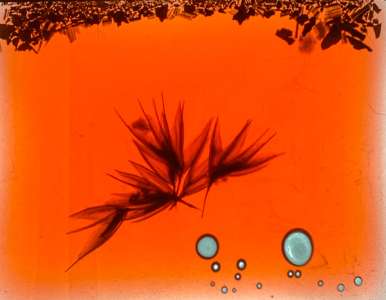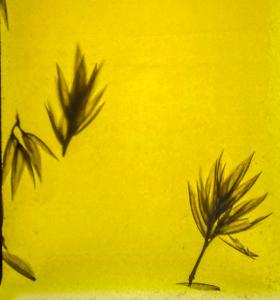
Essa Grayeb
Sun Pictures, 2020
Essa Grayeb’s Sun Pictures were commissioned for Weed Control, a group exhibition at the Qattan Foundation in Ramallah, Palestine, for which 33 artists created work based on 1940 illustrations of the most common weeds in Palestine. Grayeb was given what he calls a very “boring looking” plant, so decided to study the seeds and their growth process through photography and photograms.
He sealed the seeds inside customized photographic slides with water and air, which he then projected onto the gallery wall and photographed the resulting images. While the final visuals resemble still pictures, the water in each slide evokes a living object and creates what appear to be moving images.

‘The seeds either stick to or float inside the slides, surrounded by water and oxygen, occasionally exposed to the light from the projector. They will either continue their life cycle or decompose during the exhibition, allowing us to witness the paradox of life and death, preservation and decay.’
Since plants were among the first objects ever photographed, Sun Picturesalso refers back to the origins of the medium. Grayeb was also inspired by 19th-century author Lewis Carroll, best known for Alice's Adventures In Wonderland. Carroll – whose real name was Charles Dodgson was also a photographer, and his interest in plants is seen throughout his fiction, particularly in his vision of Wonderland.

Separate Parts Can Still Be Part of the Same Journey, 2021
Grayeb’s most recent project, Separate Parts Can Still Be Part of the Same Journey, was recently shown at the Palestinian Museum in Birzeit as part of the exhibition A People by the Sea: Narratives of the Palestinian Coast. The work began some years ago when Essa was swimming in the sea near Haifa. A sudden gust of wind sent an object flying into his face: a plastic bag marked with the words ‘Made in Lebanon’. Fascinated by the idea of a collection of objects from different countries with different identities, he began collecting trash featuring Arabic writing that he found on the shores of historical Palestine. The objects came from places in Egypt such as Port Said or Alexandria, from Tunisia, Syria, Lebanon, and many other countries around the Mediterranean.
During the collection process on the beaches, Grayeb began to see the Mediterranean as the connection between Palestine and its neighbours. While the sea has aromantic and beautiful image, the blemishes and the ‘scars’ he found on the discarded objects reminded him of the dangers faced by Palestinian families with no better option than to flee across the sea. Grayeb began to think of the objects as having more rights to move and escape than people living in the region.


‘The same trajectory that has been interrupted can still exist, even symbolically, by the movement of these objects, which reach the shores of Palestine without any restrictions, interruptions or interrogations.’

Essa Grayeb is a Palestinian visual artist working in a range of media, primarily photography, moving images, and installations.
Interview by Clara Wouters